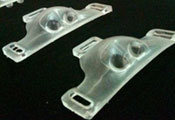NIH funding helps drive innovation in California
May / June 2012 | Volume 11, Issue 3

Photo by Carey Lee
Stanford University uses
research funds to develop
low-cost solutions for global
health problems, such as this
gadget that prevents air
leakage from breathing
machines used to treat
babies suffering from
pneumonia.
Fogarty funding is helping to drive technology development at a number of California institutions, including Stanford University, which receives many NIH grants.
Principal Investigator Dr. Michele Barry says the funding supports her state's economy in a number of ways. Grants help pay for staff positions and the training of students and fellows, as well as make possible scientific workshops, meetings and travel. Her institution leverages its federal funds, drawing additional support from foundations and private donors. In addition, Stanford collaborates with the private sector on research projects and contracts small volume manufacturers to produce its cutting-edge global health-related products.
One of Barry's programs uses Fogarty funding to support teams of faculty, postdocs, fellows or students to investigate how new medical technology might solve a global health problem. A device currently in development would help children survive pneumonia - the biggest killer of those under age five.

Photo by David Janka
Stanford University researchers
developed the AdaptAir device
(pictured) to help children
survive pneumonia.
In severe cases, fluid build-up in the lungs hampers breathing. The prototype, named AdaptAir (pictured at right), aims to ensure that breathing machines work as they should. Because the adapter typically used in developing countries comes in one standard size that doesn't always fit well, the pressurized air can escape where the tube attaches to the baby's nose. AdaptAir converts generic nasal prongs into a securely fitting, customized nasal tube interface.
Other ways in which health research funds generate economic activity in the state include:
- The global health sector supports about 350,000 high-quality jobs and generated $19.7 billion in wages, according to UC Global Health Institute (UCGHI) 2007 data.
- About 600 private, for-profit companies are engaged in global health activities and their employees earn an average salary of $71,500, according to UCGHI.
- California's academic community plays a significant role in global health, generating at least $4 billion in business activity and employing more than 12,000 people, UCGHI data show.
- Global health-related business contributes significantly to taxes, accounting for an estimated $8 billion, or 7 percent, of the $114.7 billion in total taxes in 2007, UCGHI reported.
More Information
To view Adobe PDF files,
download current, free accessible plug-ins from Adobe's website.